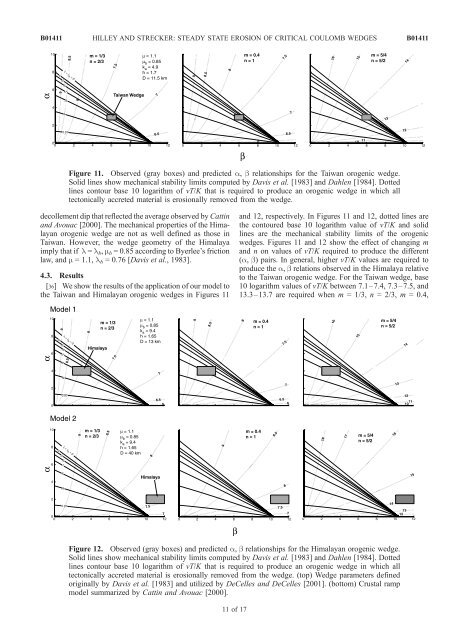Steady state erosion of critical Coulomb wedges with applications to ...
Steady state erosion of critical Coulomb wedges with applications to ...
Steady state erosion of critical Coulomb wedges with applications to ...
You also want an ePaper? Increase the reach of your titles
YUMPU automatically turns print PDFs into web optimized ePapers that Google loves.
B01411 HILLEY AND STRECKER: STEADY STATE EROSION OF CRITICAL COULOMB WEDGES<br />
Figure 11. Observed (gray boxes) and predicted a, b relationships for the Taiwan orogenic wedge.<br />
Solid lines show mechanical stability limits computed by Davis et al. [1983] and Dahlen [1984]. Dotted<br />
lines con<strong>to</strong>ur base 10 logarithm <strong>of</strong> vT/K that is required <strong>to</strong> produce an orogenic wedge in which all<br />
tec<strong>to</strong>nically accreted material is <strong>erosion</strong>ally removed from the wedge.<br />
decollement dip that reflected the average observed by Cattin<br />
and Avouac [2000]. The mechanical properties <strong>of</strong> the Himalayan<br />
orogenic wedge are not as well defined as those in<br />
Taiwan. However, the wedge geometry <strong>of</strong> the Himalaya<br />
imply that if l = l b, m b = 0.85 according <strong>to</strong> Byerlee’s friction<br />
law, and m = 1.1, l b =0.76[Davis et al., 1983].<br />
4.3. Results<br />
[36] We show the results <strong>of</strong> the application <strong>of</strong> our model <strong>to</strong><br />
the Taiwan and Himalayan orogenic <strong>wedges</strong> in Figures 11<br />
and 12, respectively. In Figures 11 and 12, dotted lines are<br />
the con<strong>to</strong>ured base 10 logarithm value <strong>of</strong> vT/K and solid<br />
lines are the mechanical stability limits <strong>of</strong> the orogenic<br />
<strong>wedges</strong>. Figures 11 and 12 show the effect <strong>of</strong> changing m<br />
and n on values <strong>of</strong> vT/K required <strong>to</strong> produce the different<br />
(a, b) pairs. In general, higher vT/K values are required <strong>to</strong><br />
produce the a, b relations observed in the Himalaya relative<br />
<strong>to</strong> the Taiwan orogenic wedge. For the Taiwan wedge, base<br />
10 logarithm values <strong>of</strong> vT/K between 7.1–7.4, 7.3–7.5, and<br />
13.3–13.7 are required when m = 1/3, n = 2/3, m = 0.4,<br />
Figure 12. Observed (gray boxes) and predicted a, b relationships for the Himalayan orogenic wedge.<br />
Solid lines show mechanical stability limits computed by Davis et al. [1983] and Dahlen [1984]. Dotted<br />
lines con<strong>to</strong>ur base 10 logarithm <strong>of</strong> vT/K that is required <strong>to</strong> produce an orogenic wedge in which all<br />
tec<strong>to</strong>nically accreted material is <strong>erosion</strong>ally removed from the wedge. (<strong>to</strong>p) Wedge parameters defined<br />
originally by Davis et al. [1983] and utilized by DeCelles and DeCelles [2001]. (bot<strong>to</strong>m) Crustal ramp<br />
model summarized by Cattin and Avouac [2000].<br />
11 <strong>of</strong> 17<br />
B01411
















